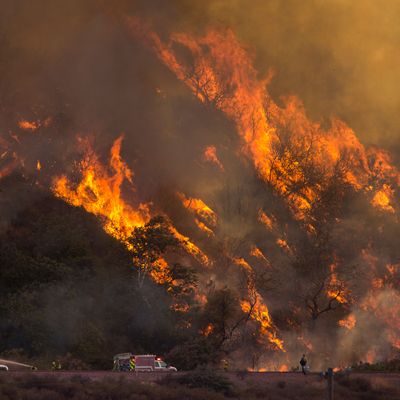
It’s been a terrifying season for what we used to call natural disasters. For the first time in recorded history, three hurricanes arose simultaneously in the Caribbean. Harvey and Irma ravaged a series of islands then turned north and hit the U.S. mainland. Days later came Maria, the third storm this season to register among the top-four most devastating hurricanes in dollar terms to ever make landfall in the U.S. (Maria seems likely to be remembered as among the worst humanitarian disasters America has ever seen, with 40 percent of Puerto Rico still without running water, power out for likely six months, and native agriculture devastated for a full year.) For years, we’ve conceived of climate change in terms of sea level, meaning it was often possible to believe its devastating impacts would be felt mostly by those living elsewhere, on the coasts; extreme weather seems poised to break that delusion, beginning with hurricanes. And then the unprecedented California wildfires broke out over the weekend, fueled by the Diablo Winds, killing 17 already and burning through 115,000 acres across several counties by Wednesday, casting even the sky above Disneyland in an eerie postapocalyptic orange glow and lighting up satellite images with flames visible from space. The smoke was visible from there, too.
It is tempting to look at this string of disasters and think, Climate change is here. Both hurricanes and wildfires are made worse by warming, with as much as 30 percent of the strength of hurricanes like Harvey and Maria attributable to climate change, and wildfire season both extended and exacerbated by it. As the journalist Malcolm Harris put it blithely on Twitter, “There didn’t used to be a major natural disaster every single day.”
But the truth is actually far scarier than “welcome to the new normal.” The climate system we have been observing since August, the one that has pummeled the planet again and again and exposed even the world’s wealthiest country as unable (or at least unwilling) to properly respond to its destruction, is not our bleak future. It is, by definition, a beyond-best-case scenario for warming and all the climate disasters that will bring. Even if, miraculously, the planet immediately ceased emitting carbon into the atmosphere, we’d still be due for some additional warming, and therefore some climate-disaster shakeout, from just the stuff we’ve put into the air already. But of course we’re very far from zeroing out on carbon, and therefore very far from stalling climate change. A recent debate has centered around the question of whether it is even conceivably possible for the planet to pull up short of one-point-five degrees Celsius of warming, which means, at the absolute very least, we have 50 percent more warming to go (since we’re at about one degree already). But even most optimistic experts expect we’ll at least hit two degrees, and possibly two-point-five or even three. That means as much as 200 percent more warming ahead of us. And what that means for extreme weather and climate disasters is horrifying.
Of course, there is also an enormous variance in weather, and we shouldn’t expect, say, that next year’s hurricane season will be necessarily as bad as this one, or worse, or that next year’s wildfire season will be as bad as this one, or worse, even as the planet continues to warm. We are probably dealing with a lot of bad luck in 2017 (and that’s not even counting the earthquakes, unrelated to climate, that shook Mexico last month, reducing whole neighborhoods to rubble). But, over time, the trend lines are inarguable: Climate change will give us more devastating hurricanes than we have now, and more horrible wildfires, as well as more tornadoes and droughts and heat waves and floods.
What that means is that we have not, at all, arrived at a new normal. It is more like we’ve taken one step out on the plank off a pirate ship. Perhaps because of the exhausting false debate about whether climate change is “real,” too many of us have developed a misleading impression that its effects are binary. But global warming is not “yes” or “no,” it is a function that gets worse over time as long as we continue to produce greenhouse gas. And so the experience of life in a climate transformed by human activity is not just a matter of stepping from one stable environment into another, somewhat worse one, no matter how degraded or destructive the transformed climate is. The effects will grow and build as the planet continues to warm: from one degree to one-point-five to almost certainly two degrees and beyond. The last few months of climate disasters may look like about as much as the planet can take. But things are only going to get worse.





























